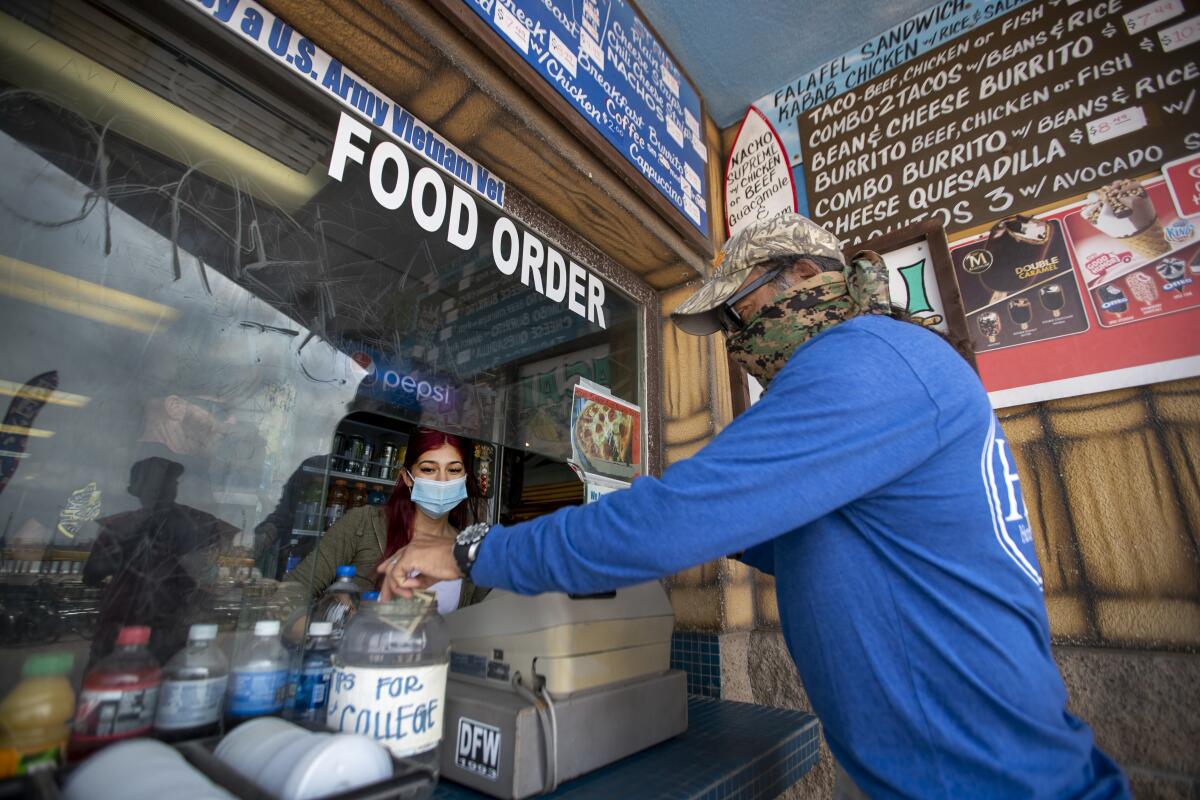Column: 5 months away from writing seems like 5 years in COVID time

- Share via
It’s been five months since my last column, but in COVID time it feels more like five years.
During my hiatus I have, no doubt like most of you, experienced many personal challenges. But I’ve also had moments of pure joy, most notably the wedding of my amazing son and his wonderful bride in a pandemic-style ceremony attended only by immediate family and a couple of bubble buddies.
It’s good to be back, even though my return is bittersweet, flavored as it is by the reality that print journalism is in grave condition. Publications across the nation have been damaged over the years by declines in readership and advertising; the COVID-driven economic collapse is accelerating that trend, leading to the closure of many news outlets and drastic cutbacks at others.
I’ve had plenty of time to ponder this sad development over the past several months and, more broadly, to wonder what the economy will look like even after the COVID crisis passes. We keep talking about getting back to normal, but it seems increasingly likely that the normal we remember might not return — not entirely, or in some cases, not at all.
The reality is that we just don’t know. The future — an elusive creature always — is even more difficult than usual to predict, and the uncertainty alone is enough to keep us awake at night. Just ask someone who is in the prediction game.
Dr. Raymond Sfeir is the director of the A. Gary Anderson Center for Economic Research at Chapman University in Orange. He produces Chapman’s vaunted economic forecasts, which are closely followed by businesses and governmental agencies.
Put another way, Sfeir is an expert at taking a slew of data, crunching the numbers, and coming up with a coherent narrative about what the economy will look like in the coming year. It’s a huge, complicated job, but Chapman’s forecasts have a solid reputation for reliability.
This year, however, is like no other because everything depends on one factor: What happens with the virus?
“Are we going to have a new wave? When will that be? Will we take a step back in employment? When will we have a vaccine? How effective will it be? All this will affect employment and the economy. And all these are complete unknowns,” Sfeir said.
That’s why most economic forecasts so far this year have been duds. When Chapman begins its analysis in early November for its annual forecast released in early December, there will at least be more information available to help get a better picture of where we’re headed.
But Sfeir is realistic about his predictive abilities amid such uncertainty. The only option, he said, is to pose three possible scenarios ranging from the most pessimistic to the most optimistic.
I suspect that the positive option might be a tough sell right now, but I wish him luck.
“We’ve basically wiped out a decade worth of job creation in a month and a half,” an economist says. May’s unemployment figures will probably look even grimmer.
To get a sense of the depth of economic harm the pandemic has wrought, consider that in April alone, Orange County lost 225,800 jobs. The previous worst month was January in 2009, during the Great Recession, when 42,300 jobs were lost. How prosaic that earlier downturn seems now.
Of course, there has been a mild recovery underway, but it’s certainly nothing to cheer about. And if the COVID crisis takes another turn for the worse — which public health experts warn is entirely possible — more economic pain will surely follow.
From what we’ve seen so far, it’s clear that some industries will continue to be hard hit.
Unsurprisingly, any type of business that relies on in-person sales and experiences — like retail stores, restaurants, and hotels — are in dire straits. Those that are designed for large gatherings — sports venues, theaters, theme parks — will be particularly slow to recover, as will the many ancillary businesses that rely on the customer traffic these large settings generate.
Disney recently announced plans to lay off 28,000 workers at its two U.S. theme parks, including Disneyland in Anaheim, a crushing blow not just to the unfortunate employees but to the entire Orange County economy. The tax revenue generated by these businesses will also plummet.
Disneyland and Walt Disney World have been severely hobbled by the COVID-19 pandemic.
Another piece of depressing news came from the Regal chain, which said it would close all 536 of its movie theaters. The shutdown, which the company portrayed as temporary, was not unexpected. Still, I can’t imagine a world without the Big Newport theater, where my sons spent many happy hours during their childhoods.
Commercial real estate is another sector on shaky ground, as many businesses might find it hard to justify the overhead of large, expensive offices after this year’s experience clearly demonstrated that many tasks can be handled off-site.
There are a few bright spots — technology companies, delivery apps, streaming services and warehousing among them — and others will likely emerge as time goes on. Economic recoveries are often fueled by innovative new ideas, and it’s entirely possible that some surprising success stories could lead the way forward.
Difficult as it is, we must not lose heart.
I have also been thinking overtime lately about my long-departed parents, who grew up in the wake of the 1918 pandemic, suffered personal tragedies, and endured the Great Depression and World War II. They knew all about hardship.
If they were here now, I know just what they’d say:
We will get through this.
All the latest on Orange County from Orange County.
Get our free TimesOC newsletter.
You may occasionally receive promotional content from the Daily Pilot.








